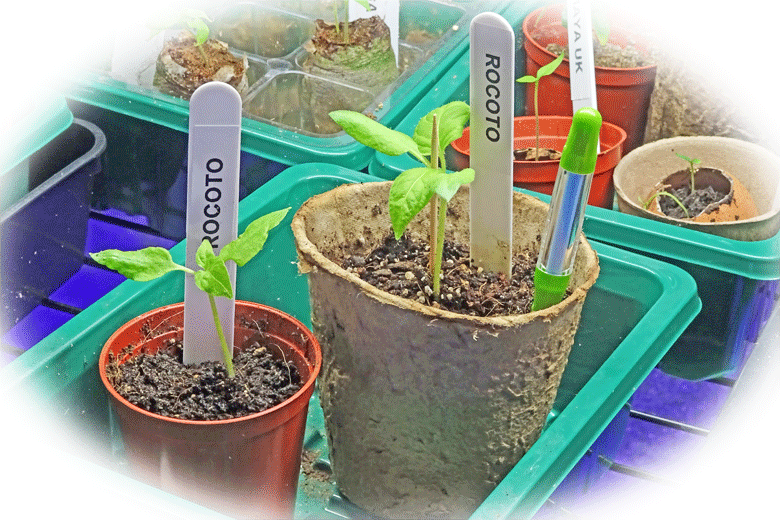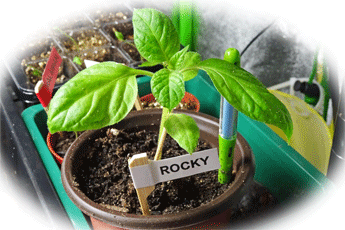
Getting rid of the gnats
I recently noticed an increase in the number of fungus gnats hovering around my Rocotos and other Chillies. While I have usually been able to keep fungus gnats under reasonable control by limiting my watering and using sticky fly paper, it just seems there are more of them around. Whether this is to do with me increasing the temperature in my grow tents, I am not sure. But one thing I do know is that I must take the bull by the horns. The time had come to get rid of these pests by using my new super weapon – hydrogen peroxide
Hydrogen when mixed to the ratio of one part 3 % H202 to four parts, water is an effective way to get rid of fungus gnat larvae and eggs. I made up a solution to this ratio and used it to treat the seed starting mix that my seedlings are planted in. To do this, I poured the solution onto the surface of the mix. The hydrogen peroxide drained through the mix and in the process killed off most of the larvae. By doing this, I hope to have broken the life cycle of the fungus gnats. Adults only live for seven days. By killing off the larvae and eggs, I will have reduced their ability to continue multiplying. It is the first step in permanently getting rid of these pests.
do this, I poured the solution onto the surface of the mix. The hydrogen peroxide drained through the mix and in the process killed off most of the larvae. By doing this, I hope to have broken the life cycle of the fungus gnats. Adults only live for seven days. By killing off the larvae and eggs, I will have reduced their ability to continue multiplying. It is the first step in permanently getting rid of these pests.
One problem solved, but potentially another was created. I have observed that when I add the H202 to seedling pots, the seed starting mix seems to expand and become “fizzy”. I have read somewhere along the line that hydrogen peroxide provides oxygen to the roots, but I also thought I had read that the fizzing is a reaction to acidity. This got me thinking – was the H202 having an impact on my seed starting mix? Was the hydrogen peroxide perhaps affecting the PH? That wouldn’t have been good, because Chillies prefer slight acidity in the seed starting and potting mixes.
My soil is fizzing!

Are bubbles trouble?
To test this, I took out my PH meter and did a test. I found the PH in a selection of pots I tested to be between 5.5 and 6.00. I was happy with that, but it would have been good to know what PH was before I treated the plants. Unfortunately, I hadn’t taken a reading. So I made up a sample batch of potting soil and added water. I tested the sample for PH, and it registered 5.5 PH. So I concluded it hadn’t affected the PH of the potting soil (at the concentration that I used it anyway).
After doing the PH test, I did some research. I discovered the fizzing was caused by the presence of an enzyme called catalase. It is because of the enzyme that hydrogen peroxide bubbles when it comes into contact with living organisms. Hydrogen peroxide is like water, but with an extra unstable oxygen molecule. The bubbling is pure oxygen being released from the H202. It is apparently this reaction that kills off the larvae and eggs of fungus gnats
Hydrogen peroxide is like water, but with an extra unstable oxygen molecule. The bubbling is pure oxygen being released from the H202. It is apparently this reaction that kills off the larvae and eggs of fungus gnats
Another thing that I have been keeping an eye on with my Rocotos is aphids. With these plants in particular, I have simply been using my finger to rub off any aphids I find on my plants. I can do this with the Rocotos, because they are part of a special project. It would however be impossible to do that with the rest of my plants. There are just too many.
To control aphids, I usually use a solution of water, liquid soap and neem oil. When my seedlings are still small, I dip them in this solution, rather than them with it. It just makes things so much simpler. However, I recently learned that 3% hydrogen peroxide mixed at a ratio of one part to three parts water is an effective treatment for killing aphids. This solution must be sprayed on plants, with special emphasis on the underside of leaves, to get rid of these pests. It is certainly something I will be trying in the not-too-distant future
Finally
The rocotos are going from strength to strength. Out of a total of six plants, I now have one that is about four inches tall, one at three and half inches, two at three inches, and the rest at about two inches tall. Rocky, the biggest Rocoto, is doing well. His leaves have developed nicely, and he is slowly making the progression from seedling to young plant. While slightly smaller, the same can be said of his brother Rocco. Hopefully, this trend will continue. I have no doubt it will. They really tough plants and seem to take any punch well!
